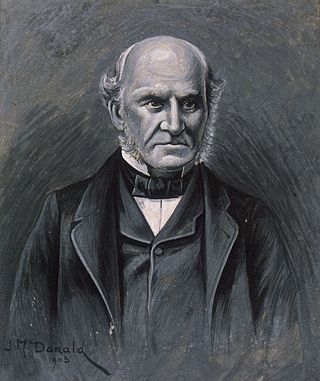| |||||
| Decades: | |||||
|---|---|---|---|---|---|
| See also: | |||||
The following lists events that happened during 1834 in New Zealand.
| |||||
| Decades: | |||||
|---|---|---|---|---|---|
| See also: | |||||
The following lists events that happened during 1834 in New Zealand.

James Busby was the British Resident in New Zealand from 1833 to 1840. He was involved in drafting the 1835 Declaration of the Independence of New Zealand and the 1840 Treaty of Waitangi. As British Resident, he acted as New Zealand's first jurist and the "originator of law in Aotearoa", to whom New Zealand "owes almost all of its underlying jurisprudence". Busby is regarded as the father of the Australian wine industry, as he brought the first collection of vine stock from Spain and France to Australia.

The United Tribes of New Zealand was a confederation of Māori tribes based in the north of the North Island, existing legally from 1835 to 1840. It received diplomatic recognition from the United Kingdom, which shortly thereafter proclaimed the foundation of the Colony of New Zealand upon the signing of the Treaty of Waitangi.

Te Waimate Mission was the fourth mission station established in New Zealand and the first settlement inland from the Bay of Islands. The members of the Church Missionary Society (CMS) appointed to establish Te (the) Waimate Mission at Waimate North were the Rev. William Yate and lay members Richard Davis, George Clarke and James Hamlin.
The following lists events that happened during 1838 in New Zealand.
The following lists events that happened during 1837 in New Zealand.
The following lists events that happened during 1836 in New Zealand.
The following lists events that happened during 1835 in New Zealand.
The following lists events that happened during 1833 in New Zealand.
The following lists events that happened during 1832 in New Zealand.
The following lists events that happened during 1829 in New Zealand.
The following lists events that happened during 1822 in New Zealand.
The following lists events that happened during 1821 in New Zealand.
The following lists events that happened during 1819 in New Zealand.
There are still far fewer ships visiting New Zealand than before 1810. This is due to the economic depression which started in New South Wales in 1810 and continues until 1815. The concern that the Boyd massacre might be repeated abates somewhat as a number of reports that it was provoked reach Port Jackson. As more ships resume visits to the Bay of Islands they consistently report that they are well treated.
Foveaux Strait is the centre of attention for sealing ships. Sealing gangs are dropped along the coast from southern Fiordland to Otago Harbour and on Stewart Island / Rakiura. The Bay of Islands is sometimes on the journey to or from Port Jackson. The Chatham Islands are also visited. A few whalers also operate around New Zealand; some also collect timber from Bay of Islands.
There is a lessening of the sealing rush at Bass Strait as the rookeries become thinner, and as a result sealers return to Dusky Sound and explore the surrounding coast. Little of the movements of these ships is actually recorded as a veil of secrecy still surrounds their activities while the various ships try to make the most of any discoveries before the competition arrives. They occasionally meet local Māori but little information regarding these encounters survives. There are again around half a dozen whalers off the north-east coast of New Zealand, a few of which call into the Bay of Islands. The first Māori to join a whaling ship, and possibly the first to leave New Zealand in 10 years, does so early in the year.
The ships visits to collect timber come to an end as the wood they have been taking, kahikatea and pōhutukawa, is found to be unsuitable for ship building. With the end of this industry the Firth of Thames area ceases to be the main point of contact for Pākehā and Māori. At the end of the year Governor King reports half a dozen whaling ships are operating off the north coast. The first recorded sealing ship visit to Dusky Sound in 4 years takes place as most sealers visit the recently discovered Bass Strait rookeries instead.
James Stack was a Wesleyan Methodist missionary at Kaeo, New Zealand, in the 19th century. He later became an Anglican missionary and a member of the Church Missionary Society (CMS). In 1827 he experienced the Wesleydale Methodist Mission being ransacked by warriors of the Ngāpuhi iwi (tribe). In the late 1830s he worked with other CMS missionaries in Te Papa Mission at Tauranga, after a war party led by Te Waharoa, the leader of the Ngāti Hauā, attacked neighbouring tribes in Rotorua and Tauranga. He later worked with William Williams in the mission to the Māori of the Gisborne District.

The flag now known as the flag of theUnited Tribes of New Zealand or Te Kara is a flag originally designed by Henry Williams to represent the New Zealand Church Missionary Society. It was adopted as a national flag by a group of rangatira in 1834 and is today more closely associated with the Māori people.

Charles Frederick Baker was an English member of the Church Missionary Society (CMS) active as a missionary in New Zealand in the 19th century. He supervised the construction of the historic church at Russell and was involved in the Treaty of Waitangi proceedings, a collection consisting of his journals and papers was added to the UNESCO Memory of the World New Zealand register in 2018.
![]() Media related to 1834 in New Zealand at Wikimedia Commons
Media related to 1834 in New Zealand at Wikimedia Commons